Abstract
This article examines the gastronomic experiences of visitors in various establishments, focusing on understanding how supply and demand operate in wine tourism. To this end, a single case study was conducted using a qualitative approach. Data collection was achieved through digitally accessible secondary sources, gathering visitors’ opinions based on publicly available information from TripAdvisor. Data analysis was facilitated using the Iramuteq tool, which combined textual analysis with subsequent manual content analysis to obtain a comprehensive overview. The study revealed that visitors perceive local gastronomy in a utilitarian manner, prioritizing the quality of products and services over cultural aspects. Furthermore, interpersonal connections and customer engagement were identified as significant factors influencing the experience. This research also contributes to the understanding of digital communication methods.
Keywords
Gastronomy; Experiences; Wine tourism; Emerging wine region; Tourism Destination
Resumo
Este artigo investiga as experiências gastronômicas dos visitantes em diferentes estabelecimentos, com foco em entender como a oferta e a demanda se comportam no enoturismo. Para isso, foi realizado um estudo de caso único com uma abordagem qualitativa. A coleta de dados foi feita por meio de fontes secundárias acessadas digitalmente, reunindo opiniões dos visitantes com base em informações públicas do TripAdvisor. A análise dos dados, facilitada com a ferramenta Iramuteq, combinou análise textual com posterior análise de conteúdo manual, para obter uma visão abrangente. O estudo mostrou que os visitantes veem a gastronomia local de maneira utilitária, valorizando mais a qualidade dos produtos e serviços do que os aspectos culturais. Além disso, as conexões interpessoais e o engajamento com o cliente foram identificados como fatores importantes que influenciam a experiência. A pesquisa também contribui para o entendimento sobre métodos de comunicação digital.
Palavras-chave
Gastronomia; Experiências; Enoturismo; Região vitivinícola emergente; Destino turístico
Resumen
Este artículo investiga las experiencias gastronómicas de los visitantes en diferentes establecimientos, con el enfoque en entender cómo se comportan la oferta y la demanda en el enoturismo. Para ello, se realizó un estudio de caso único con un enfoque cualitativo. La recopilación de datos se llevó a cabo a través de fuentes secundarias accesadas digitalmente, reuniendo opiniones de los visitantes basadas en información pública de TripAdvisor. El análisis de los datos, facilitado por la herramienta Iramuteq, combinó análisis textual con un posterior análisis de contenido manual, para obtener una visión integral. El estudio mostró que los visitantes ven la gastronomía local de manera utilitaria, valorando más la calidad de los productos y servicios que los aspectos culturales. Además, se identificaron las conexiones interpersonales y el compromiso con el cliente como factores importantes que influyen en la experiencia. La investigación también contribuye a la comprensión de los métodos de comunicación digital.
Palabras clave
Gastronomía; Experiencias; Enoturismo; Región vitivinícola emergente; Destino Turístico
1 INTRODUCTION
Gastronomy plays a crucial role in tourism by connecting visitors to a destination's cultural identity through food, encompassing social, historical, and geographical elements (Cafiero et al., 2020; Kokkranikal & Carabelli, 2021). While not always the main reason for travel, gastronomy significantly enhances the tourist experience. This enrichment extends to various hospitality settings, offering benefits to both the region's wine industry and its overall appeal (Duarte Alonso et al., 2022). This synergy between gastronomy and wine tourism underscores the diverse nature of culinary experiences in shaping tourist perceptions and preferences. Understanding this combined effect is essential for effective destination marketing and management (Charters, 2009; World Tourism Organization [UNWTO], 2023).
Additionally, comprehending the reasons behind the attraction to wine tourism and its unique attributes is vital for destinations to effectively harness the charm of wine culture and improve the overall tourism experience. Although this paper emphasizes wine tourism rather than gastronomic tourism, it is important to distinguish between the two. Gastronomic tourism emphasizes authentic culinary experiences (UNWTO, 2023), whereas wine tourism blends viticulture with services to immerse visitors in local wine culture (Marco-Lajara et al., 2023; UNWTO, 2023).
The cultural significance of the relationship between wine and gastronomy is highlighted in numerous studies (Cafiero et al., 2020; Flores et al., 2022; Gabardo & Valduga, 2021; Paulino et al., 2021). However, the strength of this connection varies depending on factors such as historical context and socio-economic conditions. For instance, non-traditional wine regions, also called emerging regions, focus on using innovative production methods and holistic approaches to enhance wine tourism. They prioritize cooperation and marketing strategies to improve the overall experience. On the other hand, traditional regions are known for their unique territorial features, culinary traditions, and historical significance (Charters, 2009; Marco-Lajara et al., 2023; Massa & Bédé, 2018; Quintal et al., 2015; Scorrano et al., 2018; Terziyska, 2022).
Although gastronomic experiences are recognized as important in wine tourism destination marketing, there is a notable gap in understanding the role of food consumption in the broader tourist experience (Kokkranikal & Carabelli, 2021). While previous studies shed light on various aspects of wine tourism (Amaral et al., 2024; Cafiero et al., 2020; Flores et al., 2022; Gabardo & Valduga, 2021; Paulino et al., 2021; Scorrano et al., 2018), none specifically address visitors' gastronomic experiences. Specifically, research on the relationship between demand and gastronomy in emerging wine destinations remains scarce, providing an opportunity for valuable empirical contributions.
This research, part of a broader study, addresses this gap by examining how visitors engage with gastronomy at various establishments within a wine region. It seeks to provide a comprehensive understanding of the supply and demand dynamics in wine tourism. Focused on the Vale dos Vinhedos, Brazil—a viticulture region in an emerging wine market (Amaral et al., 2024; de Oliveira Castro et al., 2019; Silva et al., 2016) —this research aspires to offer insights that can benefit similar regions, enhancing our understanding of the nuances of gastronomy and wine tourism. Using a demand-centered approach, the study will analyze data from user reviews on the TripAdvisor platform to evaluate visitors' dining experiences in local restaurants.
By recognizing the intrinsic connection between gastronomy and wine, this study aims to deepen our understanding of their interaction and contribute to tourism planning and management. It specifically seeks to answer the following question:
Q.1 How do factors such as consumption environments and visitor perceptions combine to shape gastronomic experiences in a wine tourism region?
The remaining sections of this paper are organized as follows. Firstly, it introduces foundational concepts that underpin experiences and gastronomy in the tourism context. Following this, the methodology section outlines the qualitative approach used to analyze visitor experiences. The subsequent section presents the outcomes of this single case study, focusing on experiences based on different types of establishments. Comparisons with findings from other studies on visitors' gastronomic experiences are drawn to contextualize and discuss the results. Finally, the paper concludes with the main findings, limitations, and recommendations for future research endeavors.
2 LITERATURE REVIEW
2.1 Tourism experience
Seminal studies by Holbrook and Hirschman (1982), Otto and Brent Ritchie (1996), Schmitt (1999), and Pine II and Gilmore (1998) have significantly shaped the concept of experience across disciplines. They emphasized the subjective nature of consumption, focusing on lived experiences, emotional impacts, and distinct dimensions of consumer engagement. These studies laid the groundwork for understanding the economic value of experiences, highlighting the importance of emotional responses and consumer loyalty. Their contributions have encouraged investigations into the psychophysical relationships in consumer behavior, the creation of memorable experiences, and the relational aspects of marketing.
In tourism, various studies emphasize the significant impact of sensory experiences on memory, attitudes, and behaviors. For example, Alnawas and Hemsley-Brown (2018) explore the effects of cognitive and emotional experiences across service sectors. Similarly, Park et al. (2023) highlight the profound influence of sensory encounters, particularly food experiences, on visitors' overall journeys, categorizing experiential elements into pre-travel, on-site, and post-travel stages. Additionally, Bernaki and Marso (2023) examine destination experiences, noting how internal reactions are influenced by external factors throughout the travel journey, leading to diverse perceptions and outcomes.
The concept of experience underscores the collaborative nature of shaping experiences by both visitors and suppliers, whereby tourist encounters are inherently personal and subjective, influenced by interactions with the environment, activities, businesses, and fellow travelers. This understanding may lead to strategies that engage visitors' senses for immersive participation in co-creating the experience, as well as subtler approaches to evoke specific feelings or an atmosphere that molds the experience (Nelson, 2023).
Other related concepts include servicescape, which focuses on the physical environment of services and plays a pivotal role in shaping deeply personal experiences that directly impact customer satisfaction and perceived service quality (Terziyska, 2022). In contrast, experiencescape influences tourist experiences by integrating stimuli within the service atmosphere and hospitality culture, thereby affecting customer responses to the product and fostering a social environment for unique experiences (Nelson, 2023; Terziyska, 2022). Moreover, storyscape involves narratives negotiated between supply and demand, shaping the tourist experience by enabling customers to co-create the essence of a place through its history (Esau & Senese, 2022). Although this research explores the interconnectedness of servicescape, experiencescape, and storyscape, the term ‘experience’ is consistently used to encompass the diverse range of situations encountered by visitors.
These situations occur within a wine tourism destination shaped by visitor demand, known as a winescape (Terziyska, 2022). In this document, the term ‘winescape’ will be used to describe such destinations. Valduga et al. (2022) explain that the concept of winescape includes not only the physical landscape but also a vibrant environment that wine tourism enthusiasts appreciate for its various aspects of wine culture.
2.2 Gastronomy in tourism
In the realm of tourism, gastronomy is often equated with culinary practices, encompassing cultural associations and culinary traditions. Martins et al. (2022) propose that while culinary practices define cultural connections and traditions, gastronomy contributes discourse, rendering it an alluring attraction for tourists by providing access to traditions and identity. Park et al. (2023) highlight the enduring significance of culinary traditions, enriching tourist experiences by serving as representations of culture and heritage. Hence, this study adopts a comprehensive perspective on gastronomy, exploring aspects such as culinary identity, imagery, food consumption, and associated experiences.
Gastronomic identity, influenced by the environment and culture, shapes the uniqueness of a tourist region (Park et al., 2023). Additionally, associating wine territories with local foods can establish a distinct regional identity (Esau & Senese, 2022). Furthermore, beyond the pleasure of eating (Kokkranikal & Carabelli, 2021; Ramírez-Gutiérrez et al., 2021), the gastronomic environment significantly impacts overall tourism experiences (Nelson, 2023; Seyitoğlu & Ivanov, 2020; Yiğit & Şahin Perçin, 2021). Thus, for a competitive advantage, the tourism industry should prioritize gastronomy (Cafiero et al., 2020).
Onorati and Giardullo (2020) stress the growing influence of recreational consumption experiences, such as dining at restaurants, on consumer decisions. Additionally, Ramírez-Gutiérrez et al. (2021) assert the importance of understanding visitors' motivations and attitudes through narratives to grasp the holistic experience, which transcends mere food consumption. Moreover, Kitsios et al. (2022) underline the significance of digital narratives in informing and attracting visitors, thereby reinforcing the impact of these experiences. These narratives provide valuable insights for tourism management, enhancing the understanding of visitor experiences and perceptions.
Scholars have explored gastronomy in wine tourism from diverse angles. Silva et al. (2016) delve into enogastronomy dynamics, highlighting its fusion of cultural and economic elements. Likewise, Rachão et al. (2019) provide an analysis from the supply side, concentrating on the synergies between food, wine, and tourism, and their implications for regional identity and traditional allure. Concurrently, Duarte Alonso et al. (2022) examine the progression of hospitality within wine tourism, with specific attention to the amenities offered by wineries in emerging wine-producing regions.
Furthermore, Rachão et al. (2021) investigate the collaborative development of wine and gastronomy experiences, expanding beyond conventional tourist destinations and considering demand from both established and non-traditional markets. In a subsequent study, Rachão et al. (2023) examine the inclination of tourists across different age cohorts to invest in food and wine experiences.
Meanwhile, Esau and Senese (2022) assess the sustainability impact of experiential wine and gastronomic tourism in traditional wine-producing areas, particularly for international educational travel. Additionally, Amaral and Tricárico (2023) explore how a wine region's gastronomic identity is conveyed through its primary channels for visitors. Conversely, other studies indirectly highlight the role of gastronomy in wine tourism. For instance, Terziyska (2022) compares gastronomy in emerging and traditional winescapes, while Tonini and Lavandoski (2011) infer the gastronomy-wine relationship from literature. Moreover, Gabardo and Valduga (2021) acknowledge gastronomy as a contributing factor to high-value-added trips.
In the winescape under study, the traditional gastronomy of Vale dos Vinhedos reflects the identity of a broader region beyond its own (Amaral & Tricárico, 2023). Previous scholarly inquiries have extensively explored the gastronomic options offered in Vale dos Vinhedos and its adjacent regions, considering diverse perspectives. These investigations have included analyses of narratives gathered through interviews with local residents (Beber & Gastal, 2017; Lavandoski et al., 2012), insights provided by stakeholders in gastronomy, viticulture, and tourism (Silva et al., 2016), testimonies from different generations of residents (Frigo et al., 2021), evaluations of restaurant menus (Colonetti et al., 2017; Lia & Nardin, 2016), compilations of traditional recipes (Perini & Gastal, 2017), reviews of promotional materials for local events (Manfio, 2021), and information shared across various digital platforms (Amaral & Tricárico, 2023).
In this study, the emphasis is on the perspective of visitors. The focus extends beyond individuals who prioritize wine, wine tourism, or gastronomy independently. Instead, it adopts the holistic approach proposed by Ramírez-Gutiérrez et al. (2021), which views visitors not only as tourists but also as diners who are actively shaped in their gastronomic experiences through perception and communication. By acknowledging visitors' dual roles, the research highlights how they influence their gastronomic encounters. This is accomplished through an examination of their communication stories, thereby emphasizing their substantial contribution to the overall gastronomic experience.
3 METHODOLOGY
3.1 Choice of study site
Vale dos Vinhedos is a prominent wine region in Serra Gaucha, Southern Brazil, renowned for its strong tourist appeal due to its gastronomy (Silva et al., 2016). Similar to other regions in the country settled by European immigrants during the 19th century, the development of gastronomic identity within Vale dos Vinhedos reflects a blend of distinctive attributes and shared elements. This amalgamation is characterized by the emergence of novel culinary traditions influenced by the immigrants' ancestral knowledge and recollections, the utilization of locally sourced ingredients, and the integration of diverse ethnicities (Colonetti et al., 2017; Martins et al., 2022).
Significantly, the Vale dos Vinhedos demonstrates a strong dedication to preserving the cultural legacy of the region, notably emphasizing the role of Italian immigrants in shaping grape cultivation, winemaking, and gastronomic practices (Silva et al., 2016). However, as Amaral and Tricárico (2023) note, the portrayal of gastronomic offerings within this winescape does not consistently align with traditional conventions. Currently, the local gastronomy scene reflects a blend of cultures, prominently showcasing Italian culinary characteristics while also integrating global gastronomic influences to a considerable degree, at times superseding local traditions.
The foundational wine culture in the Vale dos Vinhedos region traces back to the influx of immigrants, which catalyzed the development of vitiviniculture. However, it was in the subsequent century following their arrival that wine tourism emerged as a pivotal force propelling regional economic advancement, effectively transforming Vale dos Vinhedos into a sought-after tourist destination. Notably, substantial private investments surged during the 2000s, catalyzing growth across various sectors such as accommodation, gastronomy, and wineries (Valduga et al., 2022).
On a national scale, Brazil holds the 17th position globally in viticulture (International Organisation of Vine and Wine [OIV], 2023), with a significant emphasis on table wine production. Nevertheless, Vale dos Vinhedos received formal recognition in 2002 as a Geographical Indication for its fine wines, further bolstering its economic development through wine tourism. The area encompasses varying proportions of the municipalities of Bento Gonçalves (60%), Garibaldi (33%), and Monte Belo do Sul (7%) (Associação dos Produtores de Vinhos Finos do Vale dos Vinhedos [APROVALE], 2023a, 2023b).
Despite its rich cultural heritage, Brazil's vitiviniculture remains embedded within an emerging global market context (de Oliveira Castro et al., 2019; Silva et al., 2016). Additionally, this beverage consumption in Brazil is characterized by its association with lifestyle choices. Wine enthusiasts in Brazil are greatly influenced by the symbolic value of wine, which conveys status and power. This influences their attitudes and experiences, ultimately impacting their purchase intentions. Furthermore, they often develop personal connections with wine, including occasions when they choose to drink it alone (De Toni et al., 2022).
3.2 Methodological design
This study adopts an applied research approach, aiming to provide practical solutions to local issues while also exploring the problem descriptively (Ferreira De Oliveira, 2011). Primarily utilizing a qualitative approach, it employs a single case study strategy to thoroughly analyze a specific contemporary situation (Saunders et al., 2012). Data collection involves documentary research, accessing secondary sources via digital tools, and employing content analysis to gather information (Veal, 2018). All collected data is publicly accessible on TripAdvisor; however, to ensure anonymity, names and identifiers were replaced with codes (Saunders et al., 2012; Veal, 2018).
Digital methods are utilized as they highlight and incorporate visitors' perspectives through shared digital narratives. These approaches capture the distinct characteristics of this environment, leverage the research opportunities provided by various platforms, and adapt to the technical infrastructure and practices of users within these media (Ferreira De Oliveira, 2011; Venturini et al., 2018; Yoon et al., 2019). The methodologies for data collection and digital techniques in this study are primarily based on adaptations from Onorati and Giardullo (2020).
The integration of text mining and natural language processing (Onorati & Giardullo, 2020; Sant’ana et al., 2020) is applied to restaurant reviews in the three municipalities encompassed in the Vale dos Vinhedos region. Data analysis is facilitated by the use of Iramuteq software version 0.7. This tool permits classical lexicographic analysis, identifying word frequencies and exploring vocabulary. It offers complex multivariate text analysis options, such as Specificities and Correspondence Factor Analysis (CFA), which link texts to variables, enabling the analysis of texts based on characterization variables (Camargo & Justo, 2021).
CFA, as a multivariate technique, is designed to identify associations and oppositions between subjects and variables. Its key advantages over other methods include more advanced mathematics and the capability to represent both subjects and variables simultaneously on the same factorial axes (Teil, 1975). Furthermore, the tool provides Descending Hierarchical Classification (DHC) that organizes clusters based on vocabulary and segment frequency, aiming to identify classes of segments with similar characteristics through various chi-square (χ2) tests (Camargo & Justo, 2021).
In textual analysis by Iramuteq, algorithms are used to classify forms through quantitative methods like χ2 tests, which focus on lexical and textual elements. However, as this approach does not consider the perceptual content level, it is followed by a content analysis in this study. Content analysis entails examining thematic categories that can be systematically organized based on interpretations derived from theory, experience, or a combination of both (Mazieri et al., 2023). The data collection and analysis processes are illustrated in Figure 1 and elaborated upon in subsequent sections.
3.3 Data collection
TripAdvisor was chosen as the primary platform for this study due to its extensive collection of visitor reviews, global influence in tourism, and integral role in marketing strategies (Onorati & Giardullo, 2020; Xiang et al., 2017). Additionally, restaurant reviews were selected as the main data source because of their significant impact on establishments' reputations and their role in shaping the attractiveness of tourist destinations (Yoon et al., 2019). Consequently, TripAdvisor's popularity algorithm1 was utilized to identify the top five establishments in each locality (Onorati & Giardullo, 2020) within the Vale dos Vinhedos region.
From June 7th to June 23rd, 2023, data extraction was automated using the Octoparse program, gathering 16,372 reviews from 15 selected restaurants. Only comments in Portuguese were considered, aligning with the region's domestic tourism focus and the authors' native language (Vo Thanh & Kirova, 2018). This comprehensive extraction included user identification and review text details. To ensure data reliability, comments from locals and those without specified origins were excluded (Ramírez-Gutiérrez et al., 2021).
However, reviews depicting visitors' experiences beyond the designated Geographical Indication area were included, recognizing that consumption patterns may transcend geographical boundaries (Paulino et al., 2021). Short texts were disregarded as they contribute little to understanding the experience (Tripadvisor, 2021; Vo Thanh & Kirova, 2018). Additionally, reviews older than five years were excluded to focus on the current period, spanning both pre-and post-pandemic eras, resulting in a final dataset of 2,352 unique reviews.
3.4 Data analysis
The study employed an alphanumeric identification system for pseudonymization, assigning single codes to selected restaurants based on their localities. The reviews were predominantly for establishments in Bento Gonçalves (BG, 68.8%), followed by Garibaldi (GB, 21.1%) and Monte Belo (MB, 10.1%). Most reviewers identified themselves as coming from Brazil's Southeast (46%) and Southern (42%) regions. Informants from 23 states and the federal district are represented in the research, with significant contributions from São Paulo (SP, 28.15%) and Rio Grande do Sul (RS, 26.66%). The dataset remarkably comprised reviews from the pre-COVID-19 era (2018 and 2019, 61%). Though, it is important to note that this sample does not aim to represent the visitor profile provided by official tourism bodies. Since the data originate from a specific digital environment, it reflects the characteristics of the community within that context (Venturini et al., 2018).
To analyze informant experiences, the study adapted models from previous research (Boo & Kim, 2019; Onorati & Giardullo, 2020; Sant’ana et al., 2020). Text preprocessing steps were undertaken to refine the corpus for analysis. Each review was coded for variables such as the state of origin (UF), year of visit (a), and establishment (est). This analysis primarily validated the preparation of the textual corpus for further processing.
From the review texts (n) inputted into the corpus, the system identified 159,588 occurrences within the texts, comprising 5,239 different forms. Among these forms, 2,028 were hapaxes (words with unique frequency), accounting for 1.27% of the occurrences and 38.71% of the forms, with an average of 67.85 words per text. Specificities and CFA were conducted to compare textual production across different variables such as origin and establishment. Subsequently, text segments (TS) were classified using the Reinert method, resulting in six distinct clusters. Of these, 4,236 segments were classified out of a total of 4,757, resulting in a reliability of 89.05%, surpassing the minimum acceptable indicator of 75% for this technique (Camargo & Justo, 2021). Automated lexical analysis was then enhanced by manual content analysis, delving into the data to uncover underlying meanings, especially at an interpretative level (Boo & Kim, 2019).
4 RESULTS AND DISCUSSION
This section assesses informants' perceptions of gastronomic experiences within the studied winescape, specifically focusing on consumption and service at local restaurants. The analyses, which include Specificities and CFA, explore each characterizing variable and the clusters of semantic contexts. The subsequent subsections present detailed results and discussions, supported by representative quotes. These quotes, translated verbatim by the authors from the original narratives, illustrate the analyzed content and are included in Tables 1 and 2.
4. 1 Variables
This subsection analyzes user comments, focusing on visitor origin, the year the comment was published, and the establishment where the service encounter took place, using CFA. In the tool's settings, the first 50 terms with a frequency of 10 or more from each variable group were selected and displayed in different colors. The font size corresponds to the frequency of each term in the textual corpus. The CFA results were scrutinized by examining the relationship between the X and Y axes. Interpretation was carried out by closely reviewing the text segments categorized within the considered variables (see Table 1 for example extracts).
A detailed analysis of the CFA findings shows that the center of the factorial axes (0,0) represents the shared aspects of the comments based on the variables (Mazieri et al., 2023; Serra & Alfinito, 2020). Additionally, examining the contrast between the negative and positive sides of the CFA reveals axes that are not only distinct but also uncorrelated (Teil, 1975).
Origin of the visitors (UF)
Considering this variable, the terms used to share their experiences were predominantly homogeneous, as portrayed in Figure 2. For example, the ten most significant terms for the states of SP (13.83 ≤ χ² ≤ 53.71, p < 0.05) and RS (15.79 ≤ χ² ≤ 58.85, p < 0.05) were identical. This similarity reflects not only the experiences, and the establishments involved but also the choice of words used to describe them. This aligns with findings from Onorati and Giardullo (2020) and Yoon et al. (2019), which identified patterns in TripAdvisor reviews, although their studies did not analyze visitors' narratives by origin.
The content analysis revealed that the general mention of typical gastronomy was often linked to the influence of Italian immigration, with many references to Italy as the source of this distinctiveness (see Table 1). This echoes Perini and Gastal (2017) conclusion that many tourists visiting the region seek local attractions that provide a classic ‘Italian experience’.
Additionally, visitors commonly compared their experiences in terms of what ‘Brazil’ has to offer or against the standards of encounters they have had elsewhere in the country. This form of comparison aids individuals in considering information conveyed via digital platforms, thereby achieving one of the primary goals of visitor reviews.
Year of the visit (a)
The topics discussed in reviews may vary depending on when the visit happened, as noted by Ramír Ramírez-Gutiérrez et al. (2021). As an illustration, in 2021 (see Figure 3), the ‘pandemic’ emerged as a prominent topic. Seyitoğlu and Ivanov (2020) also observed a similar trend, particularly regarding changes in service offerings during the pandemic, suggesting it may be a temporary phenomenon. Conversely, terms associated with traditional dishes like ‘polenta’, local ‘wineries’, and a Brazilian service style, named ‘rodízio’, were consistently mentioned throughout the study period. These terms serve as markers of the longstanding components of the local gastronomic repertoire, recognized as emblematic of the region, as noted in earlier studies (Amaral et al., 2024; Amaral & Tricárico, 2023; Lia & Nardin, 2016; Perini & Gastal, 2017). Moreover, the number of ‘times’ a visitor frequents an establishment was often used as a measure for evaluating that place, serving the purpose of a review, as discussed by Yiğit and Şahin Perçin (2021).
Establishment (est)
Through the CFA for the variable ‘est,’ we identified what differentiates certain restaurants from the others studied. This distinction was particularly evident in MB1, GB2, and BG4, where significant differences in topics emerged from their unique offerings compared to the usual standards (Figure 4). Content analysis revealed that the proposals of these establishments can influence visitor experiences, thereby affecting the narratives they share (see Table 1).
In MB1, the emphasis is on interpersonal connections and a legacy-oriented perspective, while BG4 focuses on product and service offerings. GB2 combines elements of both. The texts from MB1 and GB2 maintain a familiar tone, often mentioning the names of those involved with the establishment. Comments about experiences at GB2 and BG4 frequently emphasize the original concept of interacting with their products.
These distinctions become clearer when examining the semantic context of the texts, which will be discussed in subsection 4.2. It is worth noting that this research approach diverges from that of Onorati and Giardullo (2020) and other studies (Nelson, 2023; Ramírez-Gutiérrez et al., 2021; Seyitoğlu & Ivanov, 2020; Yiğit & Şahin Perçin, 2021), as they analyze experiences collectively rather than focusing on individual consumption establishments.
4.2 Semantic contexts
To analyze the themes that arose from the semantic contexts of the comments, a DHC was performed using the Reinert method (Camargo & Justo, 2021; Serra & Alfinito, 2020), resulting in a graphical representation (Figure 5). This illustrated the most significant TS of each class in distinct colors, facilitating the contextualization of the characteristic vocabulary. The grouped classes were labelled as follows: gastronomy (23.3%), pre-service (19.4%), human (16.3%), product (15.9%), service (13.4%), and recommendation (11.7%). Then, the analysis was fully completed by carefully reviewing the text segments organized within the clusters (see Table 2 for example extracts).
Gastronomy
Typical elements of the local gastronomy played a significant role in the texts examined, such as ‘pasta’ (χ² = 754.05, p < 0.05) and ‘sauce’ (χ² = 720.90, p < 0.05). When the content was analyzed manually, it became evident that the comments frequently centered on detailed descriptions of menu items rather than highlighting their uniqueness or sharing genuine stories (see Table 2). This aligns with the findings of Ramírez-Gutiérrez et al. (2021), which suggest a lack of emphasis on gastronomic values and local culinary heritage.
There is also low importance placed on the symbolic dimension and cultural motivation, as noted by Cafiero et al. (2020); Martins et al.(2022) and Tonini & Lavandoski (2011). Additionally, when we consider this alongside the previously mentioned findings, it becomes clear that there is a lack of authenticity, as noted in studies of the region (Amaral & Tricárico, 2023; Lia & Nardin, 2016; Perini & Gastal, 2017). However, studies that emphasize experiences related to local culture draw different conclusions (Beber & Gastal, 2017; Frigo et al., 2021; Kokkranikal & Carabelli, 2021; Manfio, 2021; Silva et al., 2016).
Pre-service
In the pre-service class, the most significant terms identified were ‘wait’ (χ² = 328.78, p < 0.05) and ‘reservation’ (χ² = 309.95, p < 0.05). Content analysis emphasized the importance of events that take place before the dining experience starts (see Table 2). Customer satisfaction was notably affected by issues such as booking errors and long wait times for tables. This appears to be a specific challenge within the context of the restaurant operations. Yoon et al. (2019) also observed that dissatisfied customers often voiced concerns about lengthy wait times.
The experience itself involves various moments and actors. In line with this perspective, Bernaki and Marso (2023) emphasize the importance of integrating visitors' experiential viewpoints throughout their entire visit, shaped by their dynamic interactions and active engagement with destination elements and stakeholders. Park et al. (2023) echo this sentiment by advocating for the creation of a 'sense of place' to enhance the gastronomic experiences of subsequent visitors.
Human
Narratives in the human cluster emphasized personal and meaningful connections, particularly in MB1 (χ² = 1033.10, p < 0.05) and GB2 (χ² = 337.26, p < 0.05). The other most representative terms were ‘organic’ (χ² = 328.92, p < 0.05) and ‘family’ (χ² = 323.08, p < 0.05). In a thorough content analysis, it was found that the participation of family members as service providers (see Table 2) in both establishments significantly influences the creation of a narrative centered on tradition, heritage, and sustainable practices.
This is connected to Esau and Senese’s (2022) study, which highlights the multisensory richness of a winescape, intertwining storytelling with socio-cultural elements and the people involved. The findings are also consistent with Park et al. (2023), who emphasize the importance of designing environments where visitors can become psychologically familiar with local food culture and culinary customs. Furthermore, Ramírez-Gutiérrez et al. (2021) conclude that eating locally is not just about consuming food in a specific location but about being immersed in that setting.
Product
In the product cluster, there was an emphasis on delivering value, with BG4 (χ² = 790.77, p < 0.05) particularly standing out for its distinct products, such as ‘pizza’ (χ² = 755.94, p < 0.05). Additionally, it was found that the engaging wine selection process, which encourages client involvement, contributes to its distinctiveness (see Table 2). This aligns with studies highlighting the introduction of new elements into the local gastronomic scene (Amaral & Tricárico, 2023; Colonetti et al., 2017). Moreover, this resonates with Duarte Alonso et al.'s (2022) emphasis on offering a broader range of options to enrich the visitor experience and improve perceptions of offerings.
Furthermore, the analysis of the results regarding products aligns with the view that gastronomy drives regional innovation and creativity (Rachão et al., 2019) and that actively shaping the gastronomic experience increases both tourist satisfaction (Kokkranikal & Carabelli, 2021; Rachão et al., 2023). Additionally, the research indicates that visitors' active participation contributes to co-creating food and wine experiences, corroborating Rachão et al.'s (2021) findings, despite their primary attribution of this phenomenon to engagement with local culture and traditions.
However, the gastronomic encounters examined in this study, while utilitarian, exhibit a minimal association between food and wine, consistent with Terziyska's (2022) research. As Charters (2009) observes, in emerging wine regions, the association between wine and food is comparatively weaker and not intricately tied to regional gastronomy, compared to traditional wine-producing countries. Conversely, the narratives in this study placed minimal emphasis on hedonism, differing from earlier research in which hedonic experiences were more prominent (Esau & Senese, 2022; Gabardo & Valduga, 2021; Nelson, 2023; Ramírez-Gutiérrez et al., 2021).
Furthermore, the analysis of the findings clarified the contrast in the vocabulary employed to characterize ‘product’ interactions versus ‘human’ communications (see Table 2), with ‘product’ discussions centered around value and ‘human’ interactions emphasizing emotions. These relate to the conclusions drawn by Alnawas and Hemsley-Brown (2018), suggesting that encounters driven by cognition prioritize objectives and cost-effectiveness, whereas emotionally charged experiences cultivate strong emotional connections.
Service and Recommendation
Narratives in the service cluster often focused on common themes in dining experiences, emphasizing aspects that meet expected restaurant service standards and enhance the overall gastronomic experience. The ‘atmosphere’ (χ² = 386.50, p < 0.05) was notably significant, consistent with studies that stress its importance for overall satisfaction (Onorati & Giardullo, 2020; Seyitoğlu & Ivanov, 2020). References to ‘service’ (χ² = 331.88, p < 0.05) excellence also held a key position in the cluster named after it, supporting the research of Ramírez-Gutiérrez et al. (2021) and Seyitoğlu and Ivanov (2020), which highlight the crucial role of service approval in driving demand for these establishments.
The content analysis (see Table 2) reinforced that service satisfaction was closely linked to the recommendation cluster (see Figure 5). This underscores the critical role of service in generating referrals and building customer loyalty, as reflected in mentions to ‘return’ (χ² = 194.58, p < 0.05) to the establishment. Based on the characteristics of the database, it was expected that recommendations would strongly influence reviews, consistent with past research using TripAdvisor data (Kitsios et al., 2022; Onorati & Giardullo, 2020; Ramírez-Gutiérrez et al., 2021; Yiğit & Şahin Perçin, 2021). In the recommendation cluster, aspects such as food quality, service, and pricing emerged as key determinants influencing endorsements. In addition to the predominantly positive narratives identified in this study, it is noteworthy that reviews on this platform often lean towards the positive end of the spectrum, as noted by Xiang et al. (2017).
5 CONCLUSIONS
This study explored the perceptions of wine tourism destinations through the lens of gastronomic encounters, emphasizing trends, traditions, and innovations. It offers three key practical and theoretical insights. Firstly, it highlights overlooked aspects of visitors' engagement with local gastronomy in an emerging wine region. Secondly, it examines these experiences within their environments, underscoring the importance of storytelling and experiencescape in shaping gastronomic encounters. Lastly, this research enhances our understanding of digital communication methods by focusing on specific aspects of data analysis from digital platforms that are unique to their communication context, building on previous studies.
The findings from the in-depth analysis indicate that visitors frequently reference traditional elements of local gastronomy, although they predominantly perceive it in utilitarian terms, prioritizing product and service attributes over cultural dimensions. Moreover, conversations regarding the relationship between local gastronomy and wine products were sparse, suggesting its diminished importance relative to other aspects of visitor experiences. These results indicate that consumption behavior in emerging wine culture markets is primarily shaped by lifestyle preferences rather than cultural norms.
Furthermore, the perception of gastronomic experiences is notably influenced by the consumption environment, especially in establishments emphasizing original offerings. This influence is particularly evident in venues prioritizing human interaction, where storytelling intertwines with socio-cultural elements, reflecting the concept of experiential educational travel. Additionally, the introduction of novel elements to the local culinary scene, particularly those incorporating engaging experiences, enhances the uniqueness of restaurants, leading to increased overall satisfaction among visitors. Therefore, the study's focus on individual consumption establishments offers nuanced insights that differ from broader analyses of collective experiences.
The findings suggest strategies for managing businesses and offer valuable insights for governing wine regions. To enhance competitiveness, restaurants should focus on diversifying their menus, emphasizing regional ingredients that pair well with local wines, and employing innovative service techniques to create engaging sensory experiences. Improving service quality is also essential, which can be achieved by reducing wait times and enhancing customer communication to boost overall performance.
Successful implementation of these strategies will rely on collaboration among stakeholders and a visitor-focused approach, along with enhancing gastronomic offerings to highlight the region's uniqueness. Additionally, tourism governance should create narratives that emphasize the region's culinary identity. Expanding cultural and educational programs, such as cooking classes and interactive food events, could also be beneficial. Partnering with food and wine experts can further celebrate local ingredients and preserve culinary traditions, thereby enhancing the region's appeal.
5.1. Limitations and future research
Digital methods effectively highlight the unique aspects of their environment and provide valuable research opportunities, particularly in how platforms facilitate the sharing of experience narratives. However, these methods have specific limitations that must be acknowledged. For instance, while platforms like TripAdvisor improve accessibility, they also impose constraints that may restrict the capture of individual experiences by reflecting only community-specific communication patterns. This underscores the importance of recognizing these characteristics in analytical methods and utilizing both automated and manual content analysis for deeper insights (Ramírez-Gutiérrez et al., 2021).
The generalizability of the study's findings may be limited by the characteristics of the study population and sampling methods. To enhance methodological rigor and broaden the research scope, it is important to adopt an analytical framework that spans multiple digital platforms. Additionally, comparative studies across various wine tourism destinations could deepen understanding, while future research should investigate the nuanced motivations behind gastronomic experiences in non-traditional areas and explore innovative strategies to improve visitor engagement and satisfaction.
-
1
The TripAdvisor’s Popularity Ranking is determined by the quality, timeliness, and volume of user reviews a business receives, as well as the consistency of those reviews over time (TripAdvisor, n.d.).
-
How to quote: Amaral, M. M., and Flores, L. C. S. (2025). Visitors’ gastronomy experiences in a winescape. Revista Brasileira de Pesquisa em Turismo, São Paulo, 19, e-3008, 2025. https://doi.org/10.7784/rbtur.v19.3008
REFERENCES
-
Alnawas, I., & Hemsley-Brown, J. (2018). The differential effect of cognitive and emotional elements of experience quality on the customer-service provider’s relationship. International Journal of Retail and Distribution Management, 46(2), 125–147. https://doi.org/10.1108/IJRDM-03-2017-0058
» https://doi.org/10.1108/IJRDM-03-2017-0058 -
Amaral, M. M., Kuhn, V. R., Dos Anjos, S. J. G., & Flores, L. C. D. S. (2024). Experiences in a wine tourism destination from the visitors’ perspective. International Journal of Wine Business Research, 36(1), 85–102. https://doi.org/10.1108/IJWBR-05-2023-0028
» https://doi.org/10.1108/IJWBR-05-2023-0028 -
Amaral, M. M., & Tricárico, L. T. (2023). Uma análise da identidade gastronômica de um destino turístico do vinho, com base em comunicações digitais. Revista Brasileira de Pesquisa rm Turismo, 17, 2807. https://doi.org/10.7784/rbtur.v17.2807
» https://doi.org/10.7784/rbtur.v17.2807 -
Associação dos Produtores de Vinhos Finos do Vale dos Vinhedos [APROVALE]. (2023a). Indicação Geográfica. https://www.valedosvinhedos.com.br/indicacao-geografica
» https://www.valedosvinhedos.com.br/indicacao-geografica -
Associação dos Produtores de Vinhos Finos do Vale dos Vinhedos [APROVALE]. (2023b). Território. https://www.valedosvinhedos.com.br/territorio-vale-vinhedos
» https://www.valedosvinhedos.com.br/territorio-vale-vinhedos -
Beber, A., & Gastal, S. (2017). Turismo gastronômico, cultura e comida de festa. Dos Algarves: A Multidisciplinary e-Journal, 30, 57–71. https://doi.org/10.18089/damej.2017.30.5
» https://doi.org/10.18089/damej.2017.30.5 -
Bernaki, W., & Marso, S. (2023). Tourist Experience in Destinations: Rethinking a Conceptual Framework of Destination Experience. Journal of Marketing Research and Case Studies, 1–19. https://doi.org/10.5171/2023.340232
» https://doi.org/10.5171/2023.340232 -
Boo, S., & Kim, M. (2019). Tourists’ online reviews of convention centers. Journal of Convention and Event Tourism, 20(2), 135–162. https://doi.org/10.1080/15470148.2019.1582390
» https://doi.org/10.1080/15470148.2019.1582390 -
Cafiero, C., Palladino, M., Marcianò, C., & Romeo, G. (2020). Traditional agri-food products as a leverage to motivate tourists: A meta-analysis of tourism-information websites. Journal of Place Management and Development, 13(2), 195–214. https://doi.org/10.1108/JPMD-05-2019-0032
» https://doi.org/10.1108/JPMD-05-2019-0032 -
Camargo, B. V., & Justo, A. M. (2021). Tutorial para uso do software Iramuteq. Laboratório de Pscicologia Social da Comunicação e Cognição - UFSC. http://www.iramuteq.org/documentation/fichiers/Tutorial%20IRaMuTeQ%20em%20portugues_22.11.2021.pdf
» http://www.iramuteq.org/documentation/fichiers/Tutorial%20IRaMuTeQ%20em%20portugues_22.11.2021.pdf -
Charters, S. (2009). New world and mediterranean wine tourism: A comparative analysis. Tourism: An International Interdisciplinary Journal, 369–379. https://hrcak.srce.hr/52992
» https://hrcak.srce.hr/52992 - Colonetti, C. T., Maffessoni, E. C., Alcântara, P. D., & César, B. (2017). A gastronomia híbrida nos roteiros turísticos da Serra Gaúcha—RS. In L. M. P. C. Soares, M. C. R. Gullo, & S. L. G. Vianna (Eds.), XVI Encontro sobre os Aspectos Econômicos e Sociais da Região Nordeste do RS (pp. 48–63). Educs.
-
de Oliveira Castro, Á. L., de Barros Vilas Boas, L. H., de Rezende, D. C., & Pimenta, M. L. (2019). Behind the wine glass: Values that guide consumption in Minas Gerais – Brazil. British Food Journal, 121(10), 2477–2489. https://doi.org/10.1108/BFJ-05-2019-0329
» https://doi.org/10.1108/BFJ-05-2019-0329 -
De Toni, D., Pompermayer, R., Lazzari, F., & Milan, G. S. (2022). The symbolic value of wine, moderating and mediating factors and their relationship to consumer purchase intention. International Journal of Wine Business Research, 34(2), 190–211. https://doi.org/10.1108/IJWBR-01-2021-0006
» https://doi.org/10.1108/IJWBR-01-2021-0006 -
Duarte Alonso, A., Bressan, A., Kim, O. V. T., Kok, S. K., & Atay, E. (2022). Integrating tradition and innovation within a wine tourism and hospitality experience. International Journal of Tourism Research, 25(1), 169-182. https://doi.org/10.1002/jtr.2561
» https://doi.org/10.1002/jtr.2561 -
Esau, D., & Senese, D. M. (2022). Consuming Location: The Sustainable Impact of Transformational Experiential Culinary and Wine Tourism in Chianti Italy. Sustainability (Switzerland), 14(12). https://doi.org/10.3390/su14127012
» https://doi.org/10.3390/su14127012 - Ferreira De Oliveira, M. (2011). Metodologia Científica: Um manual para a realização de pesquisas em administração Universidade Federal de Goiás.
-
Flores, L. C. da S., Júnior, I. C., Fiuza, T. F., & de Oliveira Mattos da Silva Flores, G. (2022). Fatores críticos de sucesso do enoturismo em São Joaquim, Santa Catarina, Brasil: Estudo na percepção das partes interessadas. Rosa Dos Ventos - Turismo e Hospitalidade, 14(4), 1052–1072. http://dx.doi.org/10.18226/21789061.v14i4p1052
» https://doi.org/10.18226/21789061.v14i4p1052 -
Frigo, M. S., Oliveira, C. N. S., & Lunardi, R. (2021). Culinária dos Imigrantes Italianos no Brasil: Um Legado sem Herdeiros? Revista Rosa Dos Ventos - Turismo e Hospitalidade, 13(4), 988–1006. https://doi.org/10.18226/21789061.v13i4p1008
» https://doi.org/10.18226/21789061.v13i4p1008 - Gabardo, W., & Valduga, V. (2021). A Paisagem do Vinho: O gosto da experiência. In R. M. V. M. (In) & M. L. (Org.) (Eds.), Patrimônio, turismo e vitivinicultura (Vol. 1). Jad Editora Editoração Gráfica.
-
Holbrook, M. B., & Hirschman, E. C. (1982). The Experiential Aspects of Consumption: Consumer Fantasies, Feelings, and Fun. Journal of Consumer Research, 9(2), 132–140. https://doi.org/10.1086/208906
» https://doi.org/10.1086/208906 -
International Organisation of Vine and Wine [OIV]. (2023). 2023 World Wine Production—OIV first estimates (p. 9). International Organisation of Vine and Wine. https://www.oiv.int/sites/default/files/documents/OIV_World_Wine_Production_Outlook_2023.pdf
» https://www.oiv.int/sites/default/files/documents/OIV_World_Wine_Production_Outlook_2023.pdf -
Kitsios, F., Mitsopoulou, E., Moustaka, E., & Kamariotou, M. (2022). User-Generated Content in Social Media: A Twenty-Year Bibliometric Analysis in Hospitality. Information (Switzerland), 13(12). https://doi.org/10.3390/info13120574
» https://doi.org/10.3390/info13120574 -
Kokkranikal, J., & Carabelli, E. (2021). Gastronomy tourism experiences the cooking classes of Cinque Terre. Tourism Recreation Research, 49(1), 161-172. https://doi.org/10.1080/02508281.2021.1975213
» https://doi.org/10.1080/02508281.2021.1975213 -
Lavandoski, J., Tonini, H., & Barretto, M. (2012). Uva, vinho e identidade cultural na Serra Gaúcha (RS, Brasil). Revista Brasileira de Pesquisa Em Turismo São Paulo, 6(2), 216–232. https://doi.org/10.7784/rbtur.v6i2.529
» https://doi.org/10.7784/rbtur.v6i2.529 - Lia, C. F., & Nardin, C. R. (2016). Turismo gastronômico e construção de identidade para a cidade de Bento Gonçalves. MÉTIS: História & Cultura, 15(30), 193–210.
-
Manfio, V. (2021). Quarta Colônia—RS: os diálogos entre cultura, gastronomia e turismo. Ágora (St. Cruz Sul, Online), 23(1), 85–98. https://doi.org/10.17058/agora.v%vi%i.15909
» https://doi.org/10.17058/agora.v%vi%i.15909 -
Marco-Lajara, B., Martínez-Falcó, J., Millan-Tudela, L. A., & Sánchez-García, E. (2023). Analysis of the structure of scientific knowledge on wine tourism: A bibliometric analysis. Heliyon, 9(2). https://doi.org/10.1016/j.heliyon.2023.e13363
» https://doi.org/10.1016/j.heliyon.2023.e13363 -
Martins, M. R., Aguiar, A. V. B. de, & Corbari, S. D. (2022). Relação entre cultura e alimentação enquanto recurso turístico no Rio Grande do Sul: Uma revisão integrativa. Revista Arqueologia Pública, 17, 1–22. https://doi.org/10.20396/rap.v17i00.8668102
» https://doi.org/10.20396/rap.v17i00.8668102 -
Massa, C., & Bédé, S. (2018). A consumer value approach to a holistic understanding of the winery experience. Qualitative Market Research, 21(4), 530–548. https://doi.org/10.1108/QMR-01-2017-0031
» https://doi.org/10.1108/QMR-01-2017-0031 -
Mazieri, M. R., Quoniam, L. M., Reymond, D., & Cunha, K. C. T. (2023). Uso do iramuteq para análise de conteúdo baseada em classificação hierarquica descendente e análise fatorial de correspondência. ReMark - Revista Brasileira de Marketing, 21(5), 1978–2048. https://doi.org/10.5585/remark.v21i5.21290
» https://doi.org/10.5585/remark.v21i5.21290 -
Nelson, V. (2023). Reconstructing the microbrewery taproom experiencescape through narratives in online travel reviews: A case from Houston, Texas USA. Tourism and Hospitality Research, 24(3). https://doi.org/10.1177/14673584231151894
» https://doi.org/10.1177/14673584231151894 -
Onorati, M. G., & Giardullo, P. (2020). Social media as taste re-mediators: Emerging patterns of food taste on TripAdvisor. Food, Culture & Society, 23(3), 347–365. https://doi.org/10.1080/15528014.2020.1715074
» https://doi.org/10.1080/15528014.2020.1715074 -
Otto, J. E., & Brent Ritchie, J. R. (1996). The service experience in tourism. Tourism Management, 17(3), 165–174. http://dx.doi.org/10.1016/0261-5177(96)00003-9
» https://doi.org/10.1016/0261-5177(96)00003-9 -
Park, E., Muangasame, K., & Kim, S. (2023). ‘We and our stories’: Constructing food experiences in a UNESCO gastronomy city. Tourism Geographies, 25(2–3), 572–593. https://doi.org/10.1080/14616688.2021.1943701
» https://doi.org/10.1080/14616688.2021.1943701 -
Paulino, I., Lozano, S., & Prats, L. (2021). Identifying tourism destinations from tourists’ travel patterns. Journal of Destination Marketing and Management, 19 https://doi.org/10.1016/j.jdmm.2020.100508
» https://doi.org/10.1016/j.jdmm.2020.100508 - Perini, K. P., & Gastal, S. (2017). Italianidade Como Herança Cultural: A gastronomia de imigração na região turística da Serra Gaúcha. Turismo: Estudos & Práticas (RTEP/UERN), Mossoró/RN, 6(Número Especial), 78–100.
-
Pine II, B. J., & Gilmore, J. H. (1998, February). Welcome to the Experience Economy. Harvard Business Review https://hbr.org/1998/07/welcome-to-the-experience-economy
» https://hbr.org/1998/07/welcome-to-the-experience-economy -
Quintal, V. A., Thomas, B., & Phau, I. (2015). Incorporating the winescape into the theory of planned behaviour: Examining ‘new world’ wineries. Tourism Management, 46, 596–609. https://doi.org/10.1016/j.tourman.2014.08.013
» https://doi.org/10.1016/j.tourman.2014.08.013 -
Rachão, S., Breda, Z., De Oliveira Fernandes, C., Joukes, V., & Ferreira, C. (2023). Food-and-wine tourists’ willingness to pay for co-creation experiences: A generational approach. Journal of Hospitality and Tourism Management, 56, 245–252. https://doi.org/10.1016/j.jhtm.2023.06.004
» https://doi.org/10.1016/j.jhtm.2023.06.004 -
Rachão, S., Breda, Z., Fernandes, C., & Joukes, V. (2019). Enogastronomy in Northern Portugal: Destination Cooperation and Regional Identity. Advances in Hospitality and Tourism Research (AHTR), 216–237. https://doi.org/10.30519/ahtr.573163
» https://doi.org/10.30519/ahtr.573163 -
Rachão, S., de Jesus Breda, Z., de Oliveira Fernandes, C., & Joukes, V. N. P. M. (2021). Drivers of experience co-creation in food-and-wine tourism: An exploratory quantitative analysis. Tourism Management Perspectives, 37 https://doi.org/10.1016/j.tmp.2020.100783
» https://doi.org/10.1016/j.tmp.2020.100783 -
Ramírez-Gutiérrez, D., Santana-Talavera, A., & Fernández-Betancort, H. (2021). Tasting experiences of a destination’s local gastronomy on tourist communications. Tourism Recreation Research, 46(3), 345–359. https://doi.org/10.1080/02508281.2020.1799293
» https://doi.org/10.1080/02508281.2020.1799293 -
Sant’ana, R. O. de, Oliveira, A. F. B. de, & Ferreira, L. V. F. (2020). Memory, Identity and Heritage: An Analysis of the Comments Posted on Tripadvisor Website about Casa da Tapioca [Rio Grande do Norte, Brazil]. Revista Rosa Dos Ventos - Turismo e Hospitalidade, 12(4), 965–981. https://doi.org/10.18226/21789061.v12i4p965
» https://doi.org/10.18226/21789061.v12i4p965 -
Saunders, M., Lewis, P., & Thornhill, A. (2012). Research Methods for Business Students Pearson Education Limited. www.pearsoned.co.uk/saunders
» www.pearsoned.co.uk/saunders -
Schmitt, B. (1999). Experiential Marketing. Journal of Marketing Management, 15(1–3), 53–67. https://doi.org/10.1362/026725799784870496
» https://doi.org/10.1362/026725799784870496 -
Scorrano, P., Fait, M., Iaia, L., & Rosato, P. (2018). The image attributes of a destination: An analysis of the wine tourists’ perception. EuroMed Journal of Business, 13(3), 335–350. https://doi.org/10.1108/EMJB-11-2017-0045
» https://doi.org/10.1108/EMJB-11-2017-0045 -
Serra, L. S., & Alfinito, S. (2020). Comportamento do consumidor de turismo: Uma revisão sistemática da produção científica brasileira. Revista Brasileira de Pesquisa Em Turismo, 14(3), 109–133. http://dx.doi.org/10.7784/rbtur.v14i3.1913913
» https://doi.org/10.7784/rbtur.v14i3.1913913 -
Seyitoğlu, F., & Ivanov, S. (2020). Understanding the robotic restaurant experience: A multiple case study. Journal of Tourism Futures, 8(1). https://doi.org/10.1108/JTF-04-2020-0070
» https://doi.org/10.1108/JTF-04-2020-0070 -
Silva, R. do N. e, Etges, V. E., & Valduga, V. (2016). A enogastronomia como produto turístico: Dinâmicas territoriais no vale dos vinhedos – RS/Brasil. Tourism and Hospitality International Journal, 6(2), 42–57. www.isce-turismo.com https://doi.org/10.57883/thij6(2)2016.30294
» https://doi.org/10.57883/thij6(2)2016.30294» www.isce-turismo.com -
Teil, H. (1975). Correspondence factor analysis: An outline of its method. Journal of the International Association for Mathematical Geology, 7(1), 3–12. https://doi.org/10.1007/BF02080630
» https://doi.org/10.1007/BF02080630 -
Terziyska, I. (2022). Re-visiting the concept of winescape through netnography: “A tale of two cities”. Wine Economics and Policy, 11(2), 19–29. https://doi.org/10.36253/wep-12806
» https://doi.org/10.36253/wep-12806 -
Tonini, H., & Lavandoski, J. (2011). Enoturismo: Experiências e sensações no Vale dos Vinhedos (RS). Turismo Em Análise, 22(1), 25–43. https://doi.org/10.11606/issn.1984-4867.v22i1p25-43
» https://doi.org/10.11606/issn.1984-4867.v22i1p25-43 -
TripAdvisor. (n.d.). Everything You Need to Know About the Tripadvisor Popularity Ranking. Business. Retrieved 3 October 2024, from https://www.tripadvisor.com/business/insights/resources/tripadvisor-popularity-ranking
» https://www.tripadvisor.com/business/insights/resources/tripadvisor-popularity-ranking -
Tripadvisor. (2021, February). Diretrizes para publicação de avaliações. https://www.tripadvisor.com.br/Trust-lvBd3L1aU38Y-Review_posting_guidelines.html
» https://www.tripadvisor.com.br/Trust-lvBd3L1aU38Y-Review_posting_guidelines.html -
Valduga, V., Minasi, S. M., & Lohmann, G. (2022). Conceptualization of the winescape framework. In S. K. Dixit (Ed.), Routledge Handbook of Wine Tourism (1st ed., pp. 43–56). Routledge. https://doi.org/10.4324/9781003143628-5
» https://doi.org/10.4324/9781003143628-5 - Veal, A. J. (2018). Research methods for leisure and tourism (Fifth edition). Pearson.
-
Venturini, T., Bounegru, L., Gray, J., & Rogers, R. (2018). A reality check(list) for digital methods. New Media and Society, 20(11), 4195–4217. https://doi.org/10.1177/1461444818769236
» https://doi.org/10.1177/1461444818769236 -
Vo Thanh, T., & Kirova, V. (2018). Wine tourism experience: A netnography study. Journal of Business Research, 83, 30–37. https://doi.org/10.1016/j.jbusres.2017.10.008
» https://doi.org/10.1016/j.jbusres.2017.10.008 -
World Tourism Organization [UNWTO]. (2023). Gastronomy and wine tourism. https://www.unwto.org/gastronomy-wine-tourism
» https://www.unwto.org/gastronomy-wine-tourism -
Xiang, Z., Du, Q., Ma, Y., & Fan, W. (2017). A comparative analysis of major online review platforms: Implications for social media analytics in hospitality and tourism. Tourism Management, 58, 51–65. https://doi.org/10.1016/j.tourman.2016.10.001
» https://doi.org/10.1016/j.tourman.2016.10.001 -
Yiğit, S., & Şahin Perçin, N. (2021). How would you like your Turkish coffee? Tourist experiences of Turkish coffee houses in Istanbul. International Journal of Culture, Tourism, and Hospitality Research, 15(3), 443–454. https://doi.org/10.1108/IJCTHR-11-2020-0274
» https://doi.org/10.1108/IJCTHR-11-2020-0274 -
Yoon, Y., Kim, A. J., Kim, J., & Choi, J. (2019). The effects of eWOM characteristics on consumer ratings: Evidence from TripAdvisor.com. International Journal of Advertising, 38(5), 684–703. https://doi.org/10.1080/02650487.2018.1541391
» https://doi.org/10.1080/02650487.2018.1541391
Edited by
-
Editor
Glauber Eduardo de Oliveira Santos.
Publication Dates
-
Publication in this collection
28 Apr 2025 -
Date of issue
2025
History
-
Received
06 June 2024 -
Accepted
22 Nov 2024

 Visitors’ gastronomy experiences in a winescape
Visitors’ gastronomy experiences in a winescape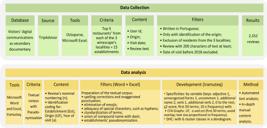
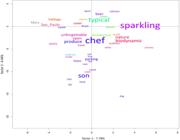

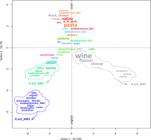
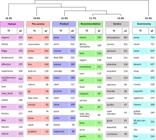

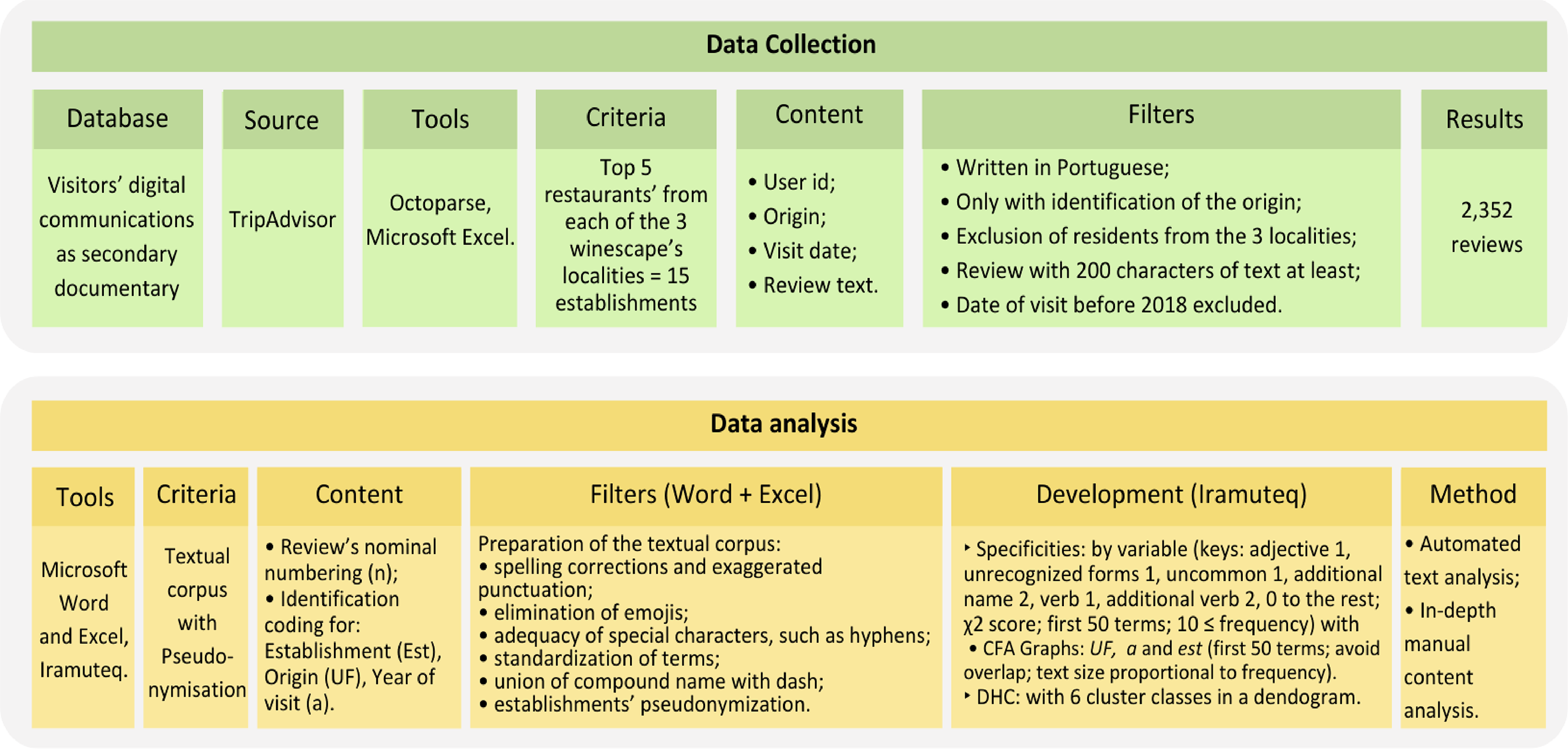 Source: authors’ elaboration.
Source: authors’ elaboration.
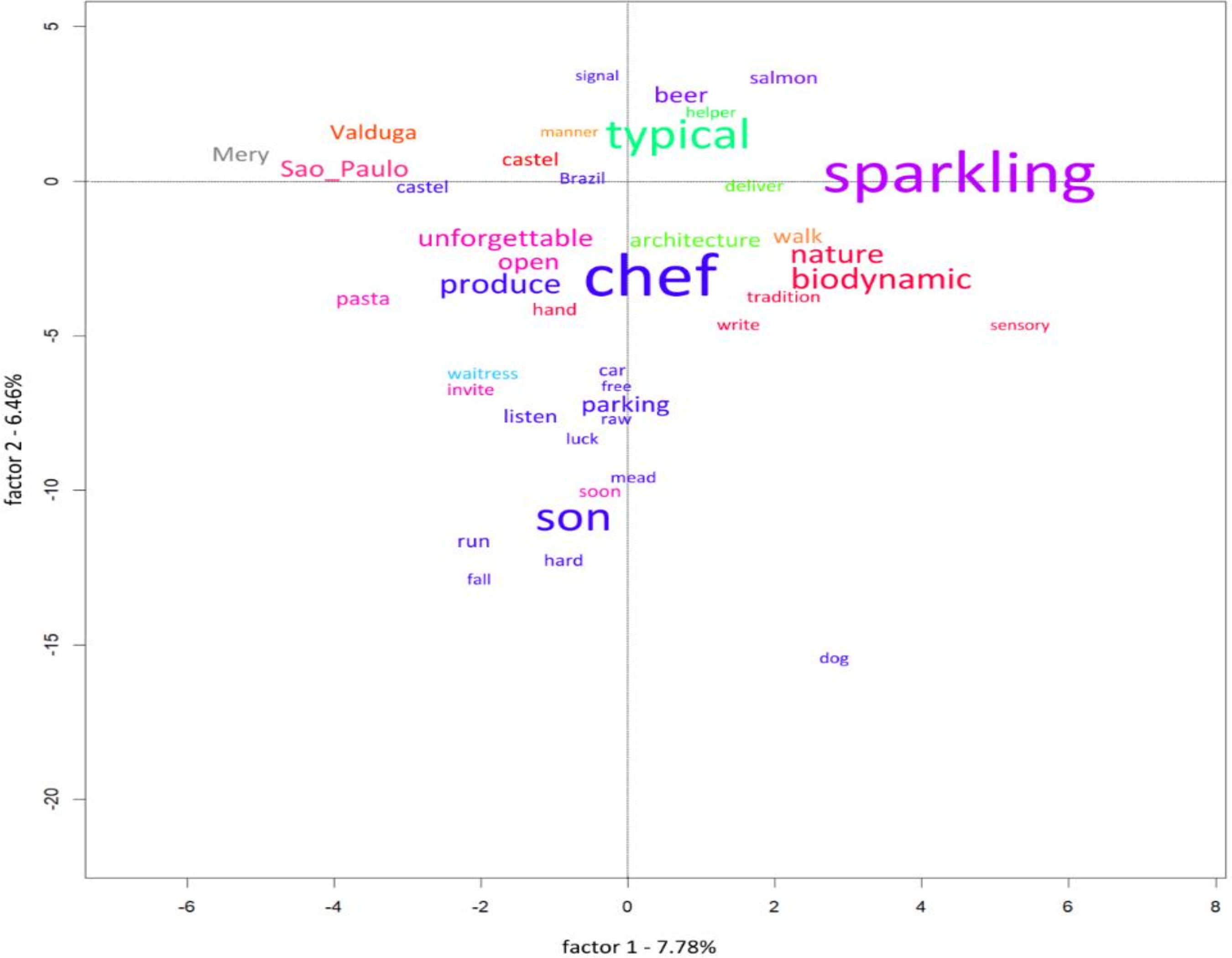 Source: Generated by Iramuteq and adapted with translation by the authors.
Source: Generated by Iramuteq and adapted with translation by the authors.
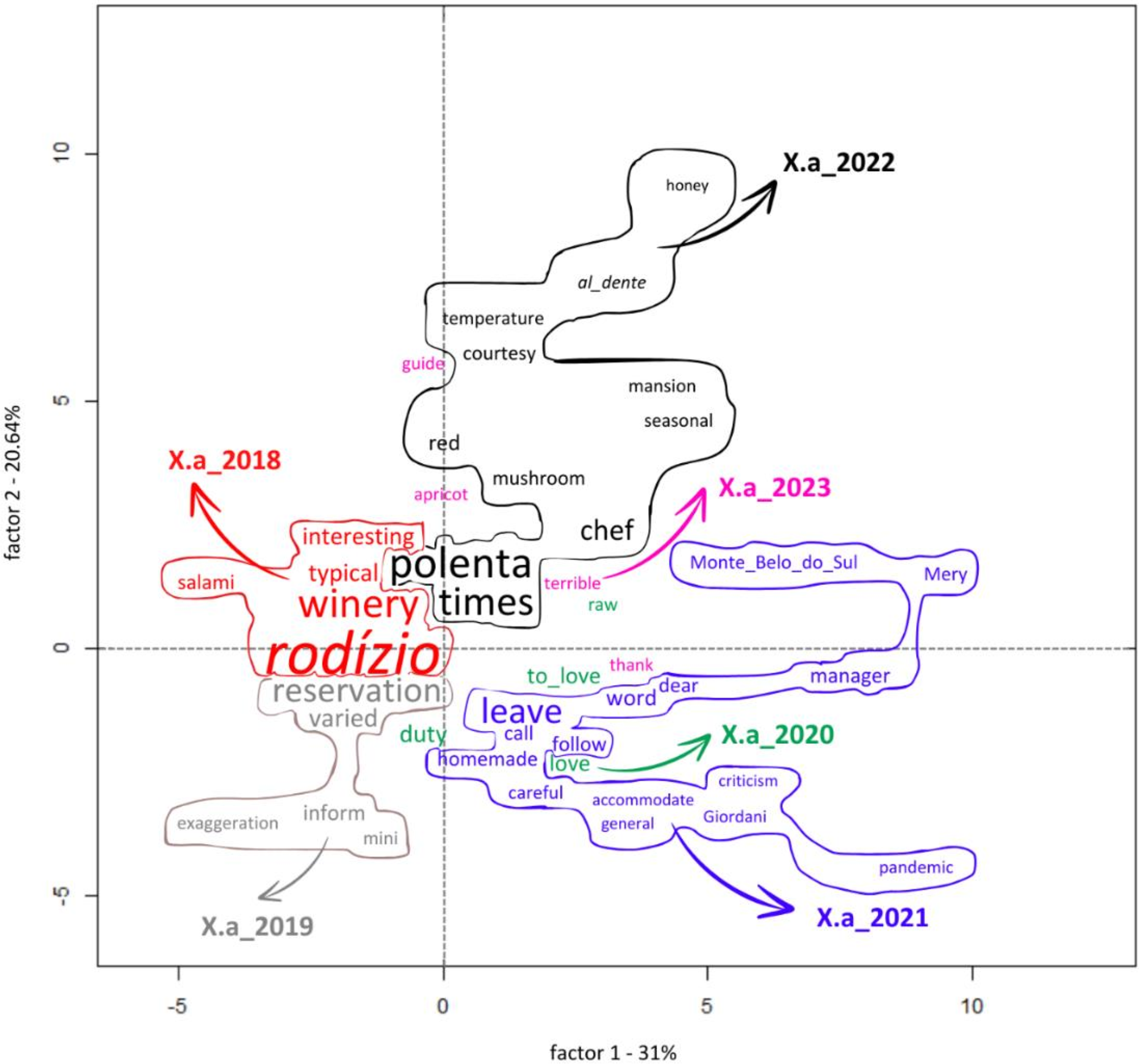 Source: Generated by Iramuteq and adapted with translation by the authors.
Source: Generated by Iramuteq and adapted with translation by the authors.
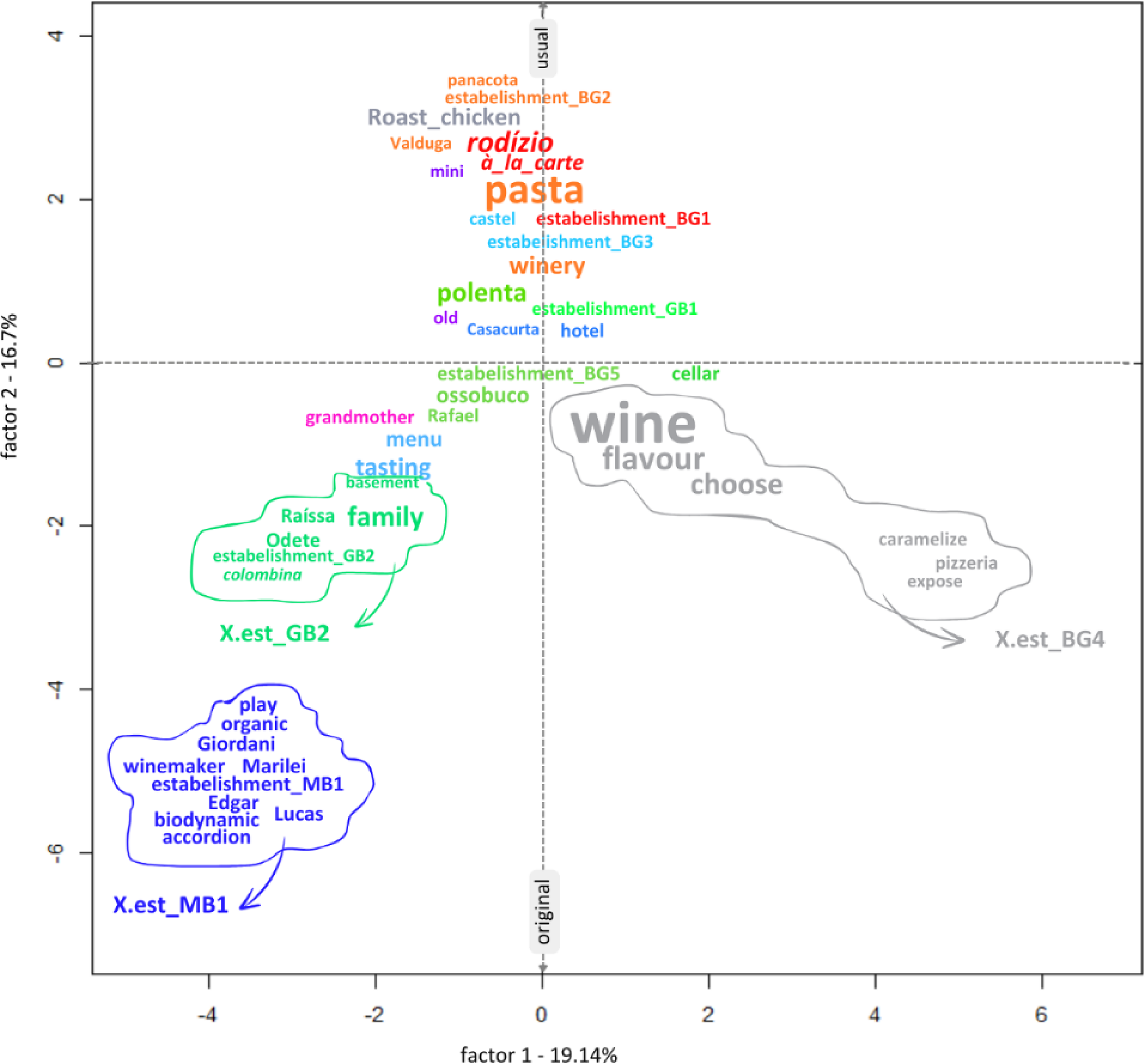 Source: Generated by Iramuteq and adapted with translation by the authors.
Source: Generated by Iramuteq and adapted with translation by the authors.
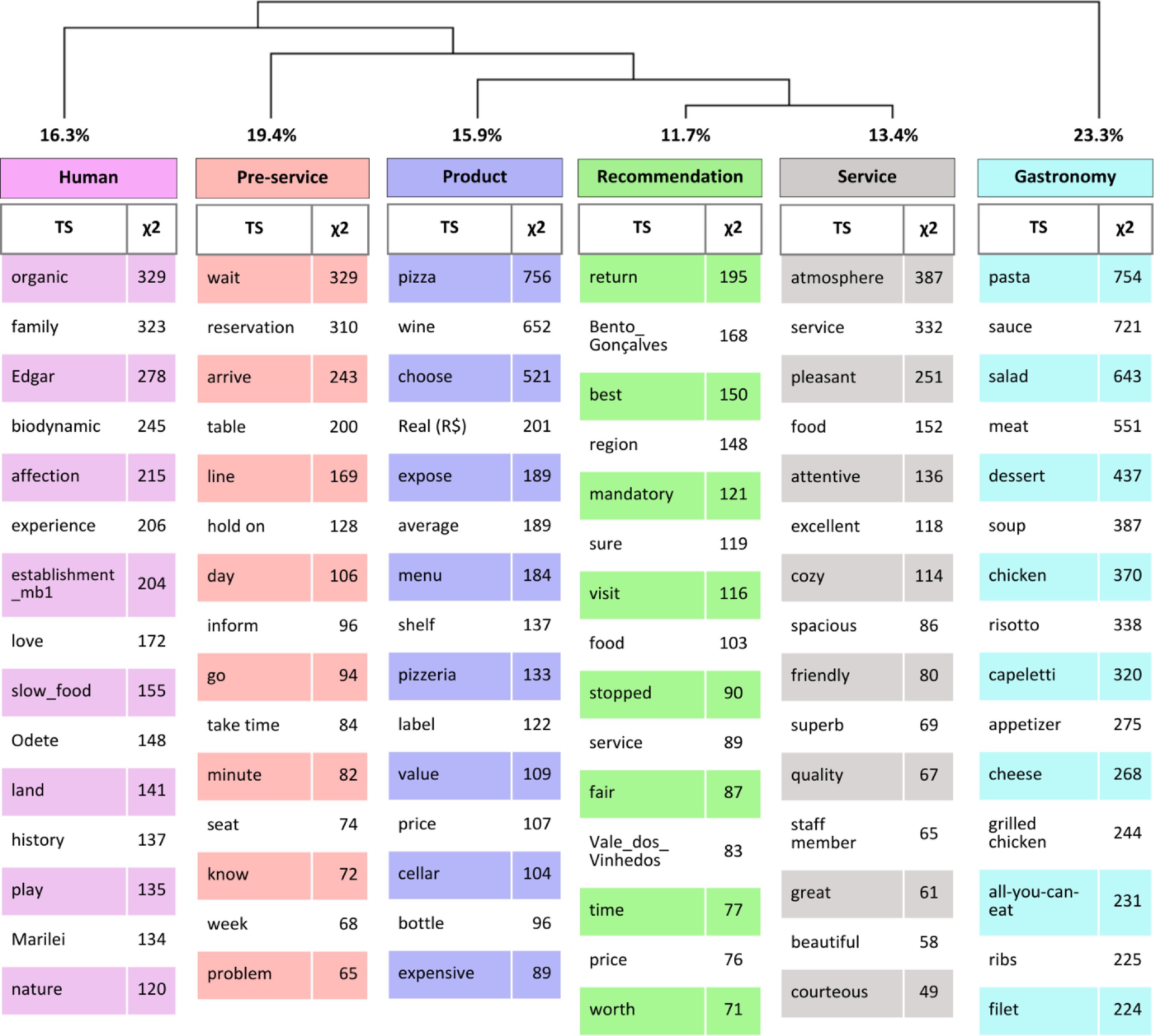 Source: Performed with Iramuteq and adapted by the authors.
Source: Performed with Iramuteq and adapted by the authors.